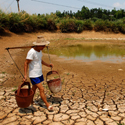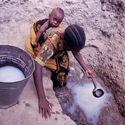water crisis – wikipeida definition
http://en.wikipedia.org/wiki/Water_crisis
Water crisis is a term that has been used by some to refer to the world├óÔé¼Ôäós water resources relative to human demand. The term has been applied to the worldwide water situation by the United Nations and other world organizations.[1][2] Others, for example the Food and Agriculture Organization, claim there is no water crisis.[3] The major aspects of the water crisis are allegedly overall scarcity of usable water[4] and water pollution.
2 billion people have gained access to a safe water source since 1990. [3] The proportion of people in developing countries with access to safe water is calculated to have improved from 30 percent in 1970[5] to 71 percent in 1990, 79 percent in 2000 and 84 percent in 2004, parallel with rising population. This trend is projected to continue. [4]
The Earth has a finite supply of fresh water, stored in aquifers, surface waters and the atmosphere. Sometimes oceans are mistaken for available water, but the amount of energy needed to convert saline water to potable water is prohibitive today, explaining why only a very small fraction of the world’s water supply derives from desalination.[6]
There are several principal manifestations of the water crisis.
* Inadequate access to safe drinking water for about 884 million people[7]
* Inadequate access to water for sanitation and waste disposal for 2.5 billion people[8]
* Groundwater overdrafting (excessive use) leading to diminished agricultural yields[9]
* Overuse and pollution of water resources harming biodiversity
* Regional conflicts over scarce water resources sometimes resulting in warfare
Waterborne diseases and the absence of sanitary domestic water are one of the leading causes of death worldwide. For children under age five, waterborne diseases are the leading cause of death. At any given time, half of the world’s hospital beds are occupied by patients suffering from waterborne diseases.[10] According to the World Bank, 88 percent of all diseases are caused by unsafe drinking water, inadequate sanitation and poor hygiene.[11]
Drought dramatizes the underlying tenuous balance of safe water supply, but it is the imprudent actions of humans that have rendered the human population vulnerable to the devastation of major droughts.
A 2006 United Nations report focuses on issues of governance as the core of the water crisis, saying “There is enough water for everyone” and “Water insufficiency is often due to mismanagement, corruption, lack of appropriate institutions, bureaucratic inertia and a shortage of investment in both human capacity and physical infrastructure”.[12] Official data also shows a clear correlation between access to safe water and GDP per capita.[13]
It has also been claimed, primarily by economists, that the water situation has occurred because of a lack of property rights, government regulations and subsidies in the water sector, causing prices to be too low and consumption too high.[14][15][16]




